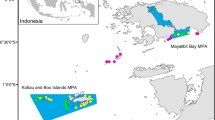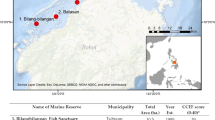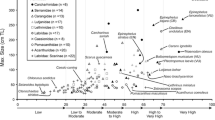Abstract
Inshore coral reefs support unique ecosystems that are subject to a variety of threats and disturbances. Marine protected areas are powerful conservation tools and often include zones which vary in the level of fishing restriction, including fully protected (no-take) zones, partially protected zones (limited fishing), and less protected “open” fishing zones. Here, we compare outcomes from fully protected, partially protected, and “open” fishing zones on inshore fringing reefs of the Great Barrier Reef with a history of cyclone-induced habitat disturbance. Biomass of target and non-target fish groups, along with the coral cover and structural complexity of benthic habitats, was compared among zones. There was a strong positive effect of full protection from fishing on targeted fish biomass, and a comparatively modest effect of partial protection, even in areas where spearfishing was prohibited. Fully protected zones supported more than three times the biomass of highly targeted coral trout (Plectropomus spp.) compared to open fishing zones, and more than twice the biomass observed in partially protected zones. Similar outcomes occurred for primary targets collectively; conversely, there were no zoning-related differences for non-target fishes. Structural complexity was a consistent positive driver of fish biomass for all fish groups and among all zones. Notably high target fish biomass occurred at NTMR sites with the highest structural complexity, highlighting the importance of both habitat and protection in supporting population hotspots for targeted reef fishes.






Similar content being viewed by others
Change history
19 January 2023
A Correction to this paper has been published: https://doi.org/10.1007/s00338-023-02344-0
References
Beukers JS, Jones GP (1998) Habitat complexity modifies the impact of piscivores on a coral reef fish population. Oecologia 114:50–59
Boaden AE, Kingsford MJ (2015) Predators drive community structure in coral reef fish assemblages. Ecosphere 6:art46
Bobiles RU, Nakamura Y (2019) Partially protected marine areas as a conservation tool for commercially important fishes in the Philippines: Do age, size, and design matter? Reg Stud Mar Sci 25
Brodie JE, Kroon FJ, Schaffelke B, Wolanski EC, Lewis SE, Devlin MJ, Bohnet IC, Bainbridge ZT, Waterhouse J, Davis AM (2012) Terrestrial pollutant runoff to the Great Barrier Reef: An update of issues, priorities and management responses. Mar Poll Bull 65:81–100
Ceccarelli D, Emslie M, Richards ZT (2016) Post-disturbance stability of fish assemblages measured at coarse taxonomic resolution masks change at finer scales. PLoS ONE 11:e0156232
Ceccarelli DM, Evans RD, Logan M, Mantel P, Puotinen M, Petus C, Russ GR, Williamson DH (2020) Long-term dynamics and drivers of coral and macroalgal cover on inshore reefs of the Great Barrier Reef Marine Park. Ecol App 30:e02008
Cinner J (2014) Coral reef livelihoods. Current Opinion in Environmental Sustainability 7:65–71
Coker DJ, Wilson SK, Pratchett MS (2014) Importance of live coral habitat for reef fishes. Rev Fish Biol Fish 24:89–126
Connell SD, Kingsford MJ (1998) Spatial, temporal and habitat related variation in the abundance of large predatory fish at One Tree Reef, Australia. Coral Reefs 17:49–57
Curley BG, Glasby TM, Curley AJ, Creese RG, Kingsford MJ (2013) Enhanced numbers of two temperate reef fishes in a small, partial-take marine protected area related to spearfisher exclusion. Biol Conserv 167:435–445
Darling ES, Graham NAJ, Januchowski-Hartley FA, Nash KL, Pratchett MS, Wilson SK (2017) Relationships between structural complexity, coral traits, and reef fish assemblages. Coral Reefs 36:561–575
Day JC, Kenchington RA, Tanzer JM, Cameron DS (2019) Marine zoning revisited: How decades of zoning the Great Barrier Reef has evolved as an effective spatial planning approach for marine ecosystem-based management. Aquat Cons: Mar Fresh Eco 29:9–32
Denny CM, Babcock RC (2004) Do partial marine reserves protect reef fish assemblages? Biol Conserv 116:119–129
Edgar GJ, Stuart-Smith RD, Willis TJ, Kininmonth S, Baker SC, Banks S, Barrett NS, Becerro MA, Bernard AT, Berkhout J, Buxton CD, Thomson RJ (2014) Global conservation outcomes depend on marine protected areas with five key features. Nature 506:216-+
Emslie M, Cheal A, Sweatman H, Delean S (2008) Recovery from disturbance of coral and reef fish communities on the Great Barrier Reef, Australia. Mar Ecol Prog Ser 371:177–190
Emslie MJ, Logan M, Williamson DH, Ayling AM, MacNeil MA, Ceccarelli D, Cheal AJ, Evans RD, Johns KA, Jonker MJ, Miller IR, Sweatman HPA (2015) Expectations and outcomes of reserve network performance following re-zoning of the Great Barrier Reef Marine Park. Curr Biol 25:983–992
Friedlander AM, Brown EK, Jokiel PL, Smith WR, Rodgers KS (2003) Effects of habitat, wave exposure, and marine protected area status on coral reef fish assemblages in the Hawaiian archipelago. Coral Reefs 22:291–305
Frisch AJ, Baker R, Hobbs JPA, Nankervis L (2008) A quantitative comparison of recreational spearfishing and linefishing on the Great Barrier Reef: implications for management of multi-sector coral reef fisheries. Coral Reefs 27:85–95
Frisch AJ, Cole AJ, Hobbs J-PA, Rizzari JR, Munkres KP (2012) Effects of Spearfishing on Reef Fish Populations in a Multi-Use Conservation Area. PLoS ONE 7:e51938
Froese R, Pauly D (2021) Fishbase
Gell FR, Roberts CM (2003) Benefits beyond boundaries: the fishery effects of marine reserves. Trends Ecol Evol 18:448–455
Graham NAJ, Ainsworth TD, Baird AH, Ban NC, Bay LK, Cinner JE, De Freitas DM, Diaz-Pulido G, Dornelas M, Dunn SR, Fidelman PI, Williamson DH (2011) From microbes to people: Tractable benefits of no-take areas for coral reefs. In: Gibson RN, Atkinson RJA, Gordon JDM (eds) Oceanography and Marine Biology: An Annual Review, Vol 49, pp105–135
Green R (1979) Sampling design and statistical methods for environmental biologists. Wiley-Interscience, New York
Hall AE, Kingsford MJ (2021) Habitat type and complexity drive fish assemblages in a tropical seascape. J Fish Biol 99:1364–1379
Hall AE, Cameron DS, Kingsford MJ (2021) Partially protected areas as a management tool on inshore reefs. Rev Fish Biol Fish 31:631–651
Hall A, Cameron D, Kingsford M (2022) Prohibiting spearfishing boosts conservation outcomes for partially protected areas. Biol Conserv 272:109662
Hannan KD, McMahon SJ, Munday PL, Rummer JL (2021) Contrasting effects of constant and fluctuating pCO2 conditions on the exercise physiology of coral reef fishes. Mar Environ Res 163:105224
Harasti D, Williams J, Mitchell E, Lindfield S, Jordan A (2018) Increase in relative abundance and size of snapper Chrysophrys auratus within partially-protected and no-take areas in a temperate marine protected area. Front Mar Sci 5
Harrison HB, Williamson DH, Evans RD, Almany GR, Thorrold SR, Russ GR, Feldheim KA, Van Herwerden L, Planes S, Srinivasan M, Berumen ML, Jones GP (2012) Larval export from marine reserves and the recruitment benefit for fish and fisheries. Curr Biol 22:1023–1028
Hughes TP (2008) Human impact on coral reefs. In: Hutchings PA, Kingsford MJ, Hoegh-Guldberg O (eds) The Great Barrier Reef: biology, environment and management. CSIRO Publishing, Collingwood, pp 85–95
Hughes TP, Kerry JT, Alvarez-Noriega M, Alvarez-Romero JG, Anderson KD, Baird AH, Babcock RC, Beger M, Bellwood DR, Berkelmans R, Bridge TC, Wilson SK (2017) Global warming and recurrent mass bleaching of corals. Nature 543:373
Jones GP, McCormick ML, Srinivasan M, Eagle JV (2004) Coral decline threatens fish biodiversity in marine reserves. Proc Nat Acad Sci 101:8251–8253
Kerry JT, Bellwood DR (2012) The effect of coral morphology on shelter selection by coral reef fishes. Coral Reefs 31:415–424
Kingsford MJ (2009) Contrasting patterns of reef utilization and recruitment of coral trout (Plectropomus leopardus) and snapper (Lutjanus carponotatus) at One Tree Island, southern Great Barrier Reef. Coral Reefs 28:251–264
Lam VYY, Chaloupka M, Thompson A, Doropoulos C, Mumby PJ (2018) Acute drivers influence recent inshore Great Barrier Reef dynamics. Proc Royal Soc B: Bio Sci 285:20182063
Lester SE, Halpern BS (2008) Biological responses in marine no-take reserves versus partially protected areas. Mar Ecol Prog Ser 367:49–56
Malcolm HA, Williams J, Schultz AL, Neilson J, Johnstone N, Knott NA, Harasti D, Coleman MA, Jordan A (2018) Targeted fishes are larger and more abundant in “no-take” areas in a subtropical marine park. Estuar Coast Shelf Sci 212:118–127
McClanahan TR, Graham NAJ, Calnan JM, MacNeil MA (2007) Toward pristine biomass: Reef fish recovery in coral reef marine protected areas in Kenya. Ecol App 17:1055–1067
McClure EC, Richardson LE, Graba-Landry A, Loffler Z, Russ GR, Hoey AS (2019) Cross-Shelf Differences in the Response of Herbivorous Fish Assemblages to Severe Environmental Disturbances. Diversity 11:13
McCook LJ, Ayling T, Cappo M, Choat JH, Evans RD, De Freitas DM, Heupel M, Hughes TP, Jones GP, Mapstone B, Marsh H, Williamson DH (2010) Adaptive management of the Great Barrier Reef: A globally significant demonstration of the benefits of networks of marine reserves. Proc Nat Acad Sci 107:18278–18285
Mellin C, Aaron MacNeil M, Cheal AJ, Emslie MJ, Julian Caley M (2016) Marine protected areas increase resilience among coral reef communities. Ecol Lett 19:629–637
Moynihan JL, Hall AE, Kingsford MJ (2022) Interrelationships between soft corals and reef-associated fishes on inshore-reefs of the Great Barrier Reef. Mar Ecol Prog Ser 698:15–28
Mumby PJ, Harborne AR (2010) Marine reserves enhance the recovery of corals on Caribbean reefs. PLoS ONE 5:1–7
Mumby PJ, Dahlgren CP, Harborne AR, Kappel CV, Micheli F, Brumbaugh DR, Holmes KE, Mendes JM, Broad K, Sanchirico JN, Buch K, Gill AB (2006) Fishing, trophic cascades, and the process of grazing on coral reefs. Science 311:98–101
Nash KL, Graham NAJ, Wilson SK, Bellwood DR (2013) Cross-scale habitat structure drives fish body size distributions on coral reefs. Ecosystems 16:478–490
Pratchett MS, Coker DJ, Jones GP, Munday PL (2012) Specialization in habitat use by coral reef damselfishes and their susceptibility to habitat loss. Ecol Evol 2:2168–2180
Russ GR, Alcala AC (2010) Decadal-scale rebuilding of predator biomass in Philippine marine reserves. Oecologia 163:1103–1106
Russ GR, Alcala AC, Maypa AP, Calumpong HP, White AT (2004) Marine reserve benefits local fisheries. Ecol App 14:597–606
Russ GR, Cheal AJ, Dolman AM, Emslie MJ, Evans RD, Miller I, Sweatman H, Williamson DH (2008) Rapid increase in fish numbers follows creation of world’s largest marine reserve network. Curr Biol 18:R514–R515
Sciberras M, Jenkins SR, Mant R, Kaiser MJ, Hawkins SJ, Pullin AS (2015) Evaluating the relative conservation value of fully and partially protected marine areas. Fish Fish 16:58–77
Sievers KT, McClure EC, Abesamis RA, Russ GR (2020) Non-reef habitats in a tropical seascape affect density and biomass of fishes on coral reefs. Ecol Evol 10:13673–13686
Turnbull JW, Johnston EL, Clark GF (2021) Evaluating the social and ecological effectiveness of partially protected marine areas. Conserv Biol 35:921–932
Webley J, McInnes K, Tiexeira D, Lawson A, Quinn R (2015) Statewide Recreational Fishing Survey 2013–14. Department of Agriculture and Fisheries
Wenger AS, Williamson DH, da Silva ET, Ceccarelli DM, Browne NK, Petus C, Devlin MJ (2015) Effects of reduced water quality on coral reefs in and out of no-take marine reserves. Conserv Biol 30:142–153
Williams DM, Hatcher A (1983) Structure of fish communities on outer slopes of inshore, mid-shelf and outer-shelf reefs of the Great Barrier Reef. Mar Ecol Prog Ser 10:239–250
Williamson D, Ceccarelli D, Evans R, Jones G, Russ GR (2014) Habitat dynamics, marine reserve status, and the decline and recovery of coral reef fish communities. Ecol evol 4:337–354
Williamson DH, Ceccarelli DM, Jones GP, Russ GR (2019) Assessing the ecological effects of management zoning on inshore reefs of the Great Barrier Reef Marine Park. Great Barrier Reef Marine Park Authority, Townsville, Australia
Williamson DH, Ceccarelli DM, Evans RD, Hill JK, Russ GR (2015) Derelict Fishing Line Provides a Useful Proxy for Estimating Levels of Non-Compliance with No-Take Marine Reserves. PLoS ONE 9:e114395
Wilson SK, Burgess SC, Cheal AJ, Emslie M, Fisher R, Miller I, Polunin NV, Sweatman HPA (2008) Habitat utilization by coral reef fish: implications for specialists vs generalists in a changing environment. J Anim Ecol 77:220–228
Woolsey E, Bainbridge SJ, Kingsford MJ, Byrne M (2012) Impacts of cyclone Hamish at One Tree Reef: integrating environmental and benthic habitat data. Mar Biol 159:793–803
Zupan M, Fragkopoulou E, Claudet J, Erzini K, Costa BHE, Goncalves EJ (2018) Marine partially protected areas: drivers of ecological effectiveness. Front Ecol Enviro 16:381–387
Acknowledgements
The authors would like to thank Stephanie Garra, Jaimee Moynihan, and Daniella Martinez for assistance with field work, and Murray Logan for advice on statistical analyses. The project was funded by a Environmental Enhancement Fund from Evolution Mining awarded to A. E. Hall.
Author information
Authors and Affiliations
Corresponding author
Ethics declarations
Conflict of interest
This research was carried out under an approved animal ethics permit # A2438. The authors have no competing interests to declare that are relevant to the content of this article.
Additional information
Publisher's Note
Springer Nature remains neutral with regard to jurisdictional claims in published maps and institutional affiliations.
Supplementary Information
Below is the link to the electronic supplementary material.
Rights and permissions
Springer Nature or its licensor (e.g. a society or other partner) holds exclusive rights to this article under a publishing agreement with the author(s) or other rightsholder(s); author self-archiving of the accepted manuscript version of this article is solely governed by the terms of such publishing agreement and applicable law.
About this article
Cite this article
Hall, A.E., Sievers, K.T. & Kingsford, M.J. Conservation benefits of no-take marine reserves outweigh modest benefits of partially protected areas for targeted coral reef fishes. Coral Reefs 42, 319–333 (2023). https://doi.org/10.1007/s00338-022-02340-w
Received:
Accepted:
Published:
Issue Date:
DOI: https://doi.org/10.1007/s00338-022-02340-w




